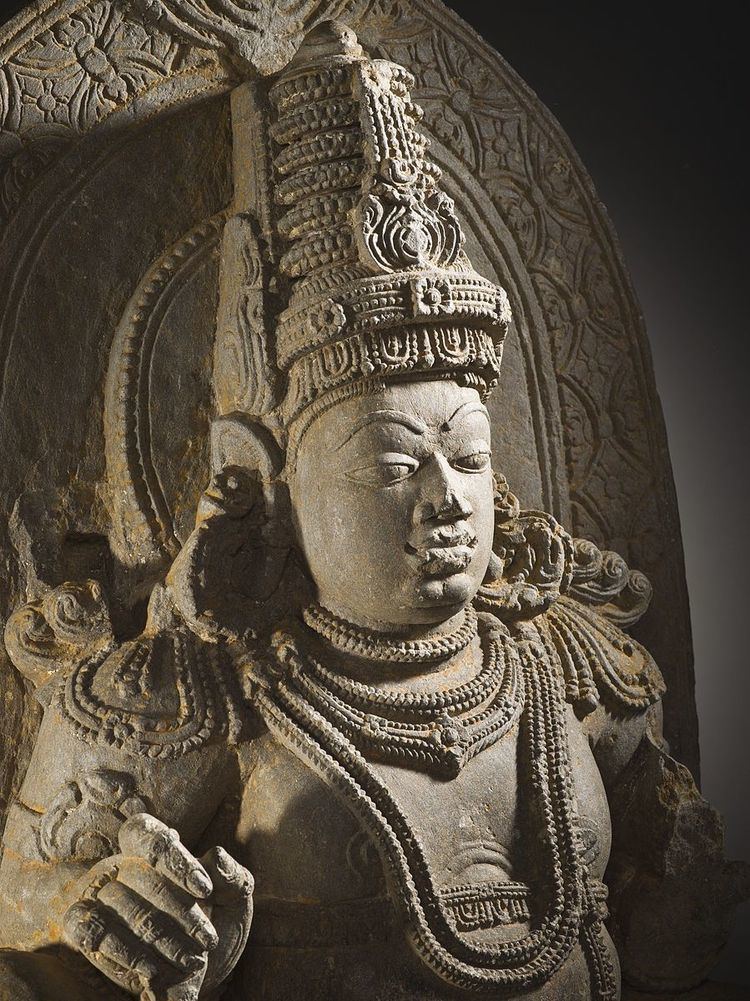 | ||
Yaksha (Sanskrit यक्ष yakṣa, Odia-ଯକ୍ଷ, Pali yakkha) is the name of a broad class of nature-spirits, usually benevolent, who are caretakers of the natural treasures hidden in the earth and tree roots. They appear in Hindu, Jain and Buddhist texts. The feminine form of the word is yakṣī or Yakshini (yakṣiṇī).
Contents
- Kubera
- Yakshas in poems
- Early Yakshas
- Yakas in Buddhism
- Yak in Thailand
- Yaksha and Yakshini in Jainism
- Yaksha in Jainism
- References
In Hindu, Jain, and Buddhist texts, the yakṣa has a dual personality. On the one hand, a yakṣa may be an inoffensive nature-fairy, associated with woods and mountains; but there is also a darker version of the yakṣa, which is a kind of ghost (bhuta) that haunts the wilderness and waylays and devours travelers, similar to the rakṣasas.
Kubera
In the Hindu Mythology Kubera (Sanskrit: कुबेर, Pali/later Sanskrit: Kuvera), also spelt Kuber, the Lord of Wealth and prosperity is considered as the god-king of the semi-divine Yakshas. He is regarded as the regent of the North (Dik-pala), and a protector of the world (Lokapala). His many epithets extol him as the overlord of numerous semi-divine species and the owner of the treasures of the world. Kubera is often depicted with a plump body, adorned with jewels, and carrying a money-pot and a club. His plump body denotes that Kubera the lord of Yakshas, is indeed a Yaksha. His (vehicle) is the viverrine (mongoose).He is often seen with another religious figure, Lakshmi (Sanskrit: लक्ष्मी, lakṣmī, ˈləkʂmiː) the Hindu goddess of wealth, fortune and prosperity. Kubera was originally described as the chief of evil spirits in Vedic-era texts, Kubera acquired the status of a Deva (god) only in the Puranas and the Hindu epics.
Yakshas in poems
In Kālidāsa's poem Meghadūta, for instance, the yakṣa narrator is a romantic figure, pining with love for his missing beloved. By contrast, in the didactic Hindu dialogue of the Yakṣapraśnāḥ "Questions of the Yakṣa", it is a tutelary spirit of a lake that challenges Yudhiṣṭhira. The yakṣas may have originally been the tutelary gods of forests and villages, and were later viewed as the steward deities of the earth and the wealth buried beneath.
In Indian art, male yakṣas are portrayed either as fearsome warriors or as portly, stout and dwarf-like. Female yakṣas, known as yakṣiṇīs, are portrayed as beautiful young women with happy round faces and full breasts and hips.
Early Yakshas
Several monumental Yashas are known from the time the Mauryan Empire period. They are variously dated from around the 3rd century BCE to the 1st century BCE. These statues are monumental (usually around 2 meters tall), and often bear inscriptions related to their identification as Yakshas. They are considered as the first known monumental stone sculptures in India. Two of these monumental Yakshas are known from Patna, one from Vidisha and one from Parkham, as well as one female Yashi from Besnagar.
Yakṣas in Buddhism
In Buddhist literature, the yakṣa are the attendants of Vaiśravaṇa, the guardian of the northern quarter, a beneficent god who protects the righteous. The term also refers to the Twelve Heavenly Generals who guard Bhaiṣajyaguru, the Medicine Buddha.
According to the Mahavamsa, Prince Vijaya encountered the royalty of the yakkhas' queen, Kuveni, in her capital of Lankapura, and conquered them. The Yakkhas served as loyal subjects with the House of Vijaya and the yakkha chieftain sat on equal height to the Sri Lankan leaders on festival days.
Yak in Thailand
Yakshas(Thai: ยักษ์, Yaksh) are an important element in Thai temple art and architecture. They are common as guardians of the gates in Buddhist temples throughout the country since at least the 14th century. Ceramic sculptures of guardian Yakshas were produced in Thailand, during the Sukhothai and Ayutthaya periods, between the 14th and 16th centuries, at several kiln complexes in northern Thailand. They are mostly depicted with a characteristic face, having big round bulging eyes and protruding fangs, as well as a green complexion. Yakshas and their female counterparts are common in the Buddhist literature of Thailand, such as in the The Twelve Sisters and Phra Aphai Mani. As ogres, giants, and ogresses, yakshas are present as well in Thai folklore.
"ย ยักษ์", (yo yak) is also used as an illustration in order to name the letter ย, the 34th consonant of the Thai alphabet, according to the traditional letter symbols Thai children use to memorize the alphabet.
Yaksha and Yakshini in Jainism
Jains mainly worship idols of Arihants and Tirthankaras, who have conquered the inner passions and attained God-consciousness status. Yaksha and Yakshini are found in pair around the idols of Jinas as guardian deities. Yaksha is generally on the right-hand side of the Jina idol and Yakshini on the left-hand side. In earlier periods, they were regarded mainly as devotees of Jina, and have supernatural powers. They are also wandering through the cycles of births and deaths just like the worldly souls, but have supernatural powers. Over time, people started worshiping these deities as well.
Jainism provides very clear foundations and guidelines, and it is up to every individual Jains to decide which idols to worship and which ones that should just be acknowledged. Sthanakvasi and Terapanthi Jains of the Svetambara and Taranpanthi Jains of the Digambaras do not believe in idol worshiping.
Yaksha in Jainism
In Jainism, there are twenty-four yakshas for twenty-four tirthankaras:
